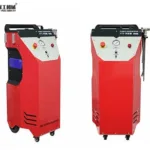Dry ice is solid carbon dioxide formed by compressing and cooling gaseous CO₂. Pelletizing dry ice enhances its handling and performance. Pellets deliver even cooling, reduced waste, improved safety, and precise dosing. Pelletized dry ice is ideal for blast cleaning, food refrigeration during transport, medical applications such as organ preservation, and stage effects in entertainment. The consistency and size distribution of pellets also determine the sublimation rate and cooling efficiency. Dry ice pellets are widely used across multiple industries for cooling, cleaning, preservation, and specialized applications such as blast cleaning and surface preparation. The dry ice pellet making machine is the heart of any operation that relies on consistent, high-quality dry ice pellets.
Advantages of Using Dry Ice Pelletizer Machines
- Eco-Friendly Cleaning Solutions
Dry ice pellets produced by dry ice pellet making machine are revolutionizing industrial cleaning. When accelerated through pressurized air, they dislodge contaminants like grease, paint, and residue without chemicals or abrasives. This method, known as dry ice blasting, is non-toxic, non-flammable, and generates minimal waste. - Enhanced Refrigeration Efficiency
In food transportation and medical storage, dry ice pellets provide superior cooling compared to wet ice. Their sublimation process ensures products remain dry and undamaged, while their compact size allows for precise temperature control. - Versatility Across Industries
From aerospace component cleaning to pharmaceutical cold chain management, dry ice pellets adapt to diverse needs. Their inert nature also makes them safe for use in electronics manufacturing and historical preservation.
Choosing The Right Dry Ice Pellet Making Machine
Required Production Capacity (kg/hour or lbs/hour): Estimate your peak and average dry ice consumption. Choose a machine that can comfortably meet peak demand without running constantly at maximum capacity. Overestimating is often better than underestimating.
Pellet Size Requirements: Determine the primary pellet diameter(s) needed for your application(s). Ensure the machine offers the necessary die plates, and inquire about the ease and cost of changing them. Common sizes are 3mm, 6mm, 10mm, 16mm, and 19mm.
Footprint and Installation Space: Consider the physical dimensions of the machine and the required clearance around it for operation, maintenance, and placement. Proper ventilation is non-negotiable.


